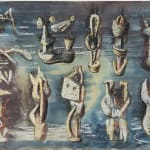Henry Moore 1898-1986
Standing Forms, 1940
watercolour, ink, wax resist and coloured crayonon paper
10 x 16 7/8 in
25.3 x 43 cm
25.3 x 43 cm
signed and dated lower right
The late 30s and early 40s marked a period of renewed interest in drawing for Moore. These drawings were works within their own right but also can be seen as...
The late 30s and early 40s marked a period of renewed interest in drawing for Moore. These drawings were works within their own right but also can be seen as explorations into form, as seen in Standing Forms, 1940, where Moore toys with ideas for sculptures.
Drawing would present Moore with an opportunity to take off on a voyage of exploration, where he would gradually develop an idea or explore different forms and themes. In Standing Forms we see Moore expanding the plastic possibilities of the standing shape. Drawing ones eye from the top row down, we see forms indicative of his reclining figures, his interior and exterior forms, some of which that can be seen to inform his later sculptures. Although his forms are isolated from one other, there is a sense of harmony and unification between them. Each form possesses a particular depth and speaks of sculptural qualities, which is expressed through the use of wax resist against the varyingly dark washes of the background. The contours are defined with black ink, and yellow and orange crayons guide one's attention to highlighted features of each form. The top left form with its abstracted shape bears particular resemblance to Moore's Reclining Figure, conceived in 1938 (see Robert Melville, Henry Moore, Sculpture and drawings 1921-1969, London, 1970, no. 176, illustrated.)
The chiaroscuro of Standing Forms - where white floating figures emerge from the dark washes of the background - creates a romantically dramatic atmosphere. This alludes to the Surrealist element present in Moore's sculptural output from the previous five years. It is curious to note how the notion of the human figure penetrates these abstract forms - an allusion to the celebrated series of Shelter drawings Moore was to complete the following year.
Standing Forms marks a transitional moment, between the abstracted surrealist forms which captured Moore's imagination in the late 30s and his shift of focus during the war. It provides an exciting insight into Moore's in the years before he achieved worldwide fame.
Drawing would present Moore with an opportunity to take off on a voyage of exploration, where he would gradually develop an idea or explore different forms and themes. In Standing Forms we see Moore expanding the plastic possibilities of the standing shape. Drawing ones eye from the top row down, we see forms indicative of his reclining figures, his interior and exterior forms, some of which that can be seen to inform his later sculptures. Although his forms are isolated from one other, there is a sense of harmony and unification between them. Each form possesses a particular depth and speaks of sculptural qualities, which is expressed through the use of wax resist against the varyingly dark washes of the background. The contours are defined with black ink, and yellow and orange crayons guide one's attention to highlighted features of each form. The top left form with its abstracted shape bears particular resemblance to Moore's Reclining Figure, conceived in 1938 (see Robert Melville, Henry Moore, Sculpture and drawings 1921-1969, London, 1970, no. 176, illustrated.)
The chiaroscuro of Standing Forms - where white floating figures emerge from the dark washes of the background - creates a romantically dramatic atmosphere. This alludes to the Surrealist element present in Moore's sculptural output from the previous five years. It is curious to note how the notion of the human figure penetrates these abstract forms - an allusion to the celebrated series of Shelter drawings Moore was to complete the following year.
Standing Forms marks a transitional moment, between the abstracted surrealist forms which captured Moore's imagination in the late 30s and his shift of focus during the war. It provides an exciting insight into Moore's in the years before he achieved worldwide fame.
Provenance
Anonymous sale Sotheby's, London, 3 April 1963, lot 128, as 'Ideas for Sculpture'Private Collection, UK



